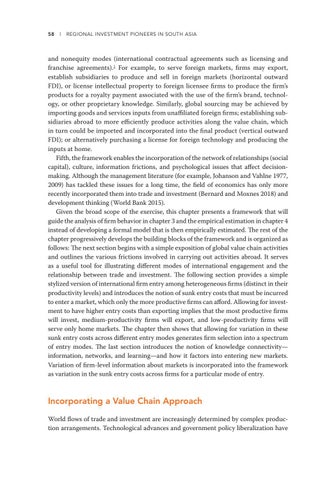58 l REGIONAL INVESTMENT PIONEERS IN SOUTH ASIA
and nonequity modes (international contractual agreements such as licensing and franchise agreements).1 For example, to serve foreign markets, firms may export, establish subsidiaries to produce and sell in foreign markets (horizontal outward FDI), or license intellectual property to foreign licensee firms to produce the firm’s products for a royalty payment associated with the use of the firm’s brand, technology, or other proprietary knowledge. Similarly, global sourcing may be achieved by importing goods and services inputs from unaffiliated foreign firms; establishing subsidiaries abroad to more efficiently produce activities along the value chain, which in turn could be imported and incorporated into the final product (vertical outward FDI); or alternatively purchasing a license for foreign technology and producing the inputs at home. Fifth, the framework enables the incorporation of the network of relationships (social capital), culture, information frictions, and psychological issues that affect decisionmaking. Although the management literature (for example, Johanson and Vahlne 1977, 2009) has tackled these issues for a long time, the field of economics has only more recently incorporated them into trade and investment (Bernard and Moxnes 2018) and development thinking (World Bank 2015). Given the broad scope of the exercise, this chapter presents a framework that will guide the analysis of firm behavior in chapter 3 and the empirical estimation in c hapter 4 instead of developing a formal model that is then empirically estimated. The rest of the chapter progressively develops the building blocks of the framework and is organized as follows: The next section begins with a simple exposition of global value chain activities and outlines the various frictions involved in carrying out activities abroad. It serves as a useful tool for illustrating different modes of international engagement and the relationship between trade and investment. The following section provides a simple stylized version of international firm entry among heterogeneous firms (distinct in their productivity levels) and introduces the notion of sunk entry costs that must be incurred to enter a market, which only the more productive firms can afford. Allowing for investment to have higher entry costs than exporting implies that the most productive firms will invest, medium-productivity firms will export, and low-productivity firms will serve only home markets. The chapter then shows that allowing for variation in these sunk entry costs across different entry modes generates firm selection into a spectrum of entry modes. The last section introduces the notion of knowledge connectivity— information, networks, and learning—and how it factors into entering new markets. Variation of firm-level information about markets is incorporated into the framework as variation in the sunk entry costs across firms for a particular mode of entry.
Incorporating a Value Chain Approach World flows of trade and investment are increasingly determined by complex production arrangements. Technological advances and government policy liberalization have

